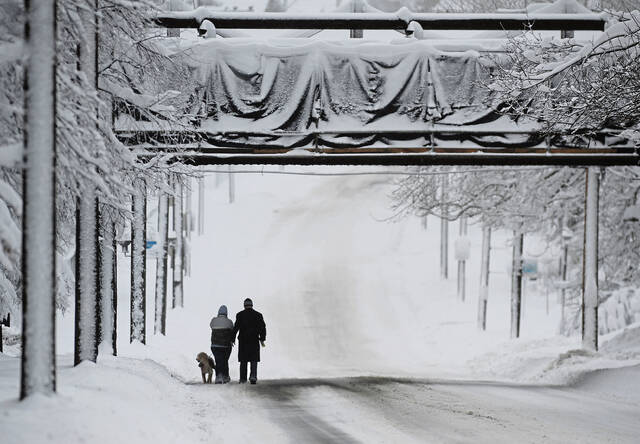https://mirror.triblive.com/local/regional/weather-forecasting-meteorological-terms-have-meaning/
Atmospheric river? The meaning behind unusual meteorological terms

When tuning into the weather report, don’t be surprised if the on-air personality mentions the term “atmospheric river.”
It’s definitely a real weather term, albeit one less heard, but it’s nothing like Pittsburgh’s other three such bodies of water.
“It is mostly a term used on the West Coast for us in the U.S.,” said Lee Hendricks, meteorologist for the National Weather Service Pittsburgh in Moon. “It’s a stream of moisture along the West Coast from Latin America into California. The warm, moist air pushes up into mountains and fuels heavier rains, like they have had there the past couple of weeks. You get a lot of rain and then some.”
Hendricks said something similar is possible on the East Coast if there happen to be winds that transport water vapor, but that occurrence would be less frequent, smaller and shorter in duration than what the other side of the country is experiencing.
He added that an atmospheric river is easier to spot on satellite on the West Coast because it’s so large.
It definitely can be, agreed Jon Nese, a teaching professor in the department of meteorology and atmospheric science at Penn State University. An atmospheric river is a long and narrow region in the atmosphere that transports lots of moisture often out of the tropics, Nese said.
“It’s akin to a river on earth (that) moves water from one place to another, only this is happening in the atmosphere,” Nese said. “It isn’t moving water, but water vapor used to make rain.”
The term was coined in the mid-1990s, Nese said, and has been more widely used the past 10 years. He first read about it in geophysical research letters.
Weather terms mean something, both Hendricks and Nese said. They aren’t just made-up words.
“Everything has meaning and sometimes meteorologists get nervous when these terms become popularized because they get misused,” Nese said. “There are formal definitions for weather terms.”
Sometimes these words become first known during a weather happening, like last June when mammatus clouds were spotted in Pittsburgh. These unique-looking clouds that sort of look like they are drooping from the sky created a social media storm. The name comes from the Latin word “mamma,” which means “udder.”
“They resemble a cow’s udder,” Nese said.
Another seemingly odd weather term is “bomb cyclone,” referring to a very powerful low-pressure system that rapidly forms and strengthens, usually within less than 24 hours, Hendricks said.
A “polar vortex” is in the arctic 24/7, 365 days of the year. When it affects this area, it’s from a strong push of cold air that usually comes down from Canada, Hendricks said.
“It is characterized by extremely cold temperatures and dry air like we experienced on Christmas Eve (in 2022),” he said.
Something called a “dust devil” is prominent in Texas, Arizona, New Mexico, Nevada and parts of California.
“Some of them can be so severe that I’ve seen them flip small airplanes,” Hendricks said.
With “thunder snow,” there is, in fact thunder, and lightning and snow.
“It is unusual but it does happen,” Nese said.
Thunder snow is most common in northwestern Pennsylvania, Erie, Crawford County and northeastern Ohio, according to Hendricks. It picks up moisture from the Great Lakes and can produce three to four inches of snow in an hour.
“If thunder snow is predicted, prepare for the worst,” Hendricks said. “Even a snow squall can be dangerous, because visibility might go from five feet to 50 yards. And it can happen fast. There was just one in Moon.”
This winter’s mild nature has been controlled by La Niña, Hendricks said, which is why it’s been milder and dryer. He said March should continue with below-normal temperatures and near-normal precipitation. He doesn’t expect any major snow storms like the blizzard of March 1993 — 30 years ago this week.
“Blizzard,” a term this region is more familiar with, has a specific meaning. According the National Weather Service, winds need to be at least 35 mph and visibility less than a quarter mile because of snow — and those conditions have to be in play for three or more consecutive hours.
In 1993 the blizzard came because of a combination of different factors, Hendricks said. A strong storm moved up the East Coast and ended up sitting over the Appalachian Mountains, and warm air mixed with cold air.
Hendricks recalled driving to work for the midnight shift and a policeman waving at him to stop.
“I thought he needed help, but he said it was too dangerous to travel,” Hendricks said. “I told him that I am a meteorologist going to work. Meteorologists can’t use the weather as an excuse not to make it to work.”
Copyright ©2025— Trib Total Media, LLC (TribLIVE.com)
